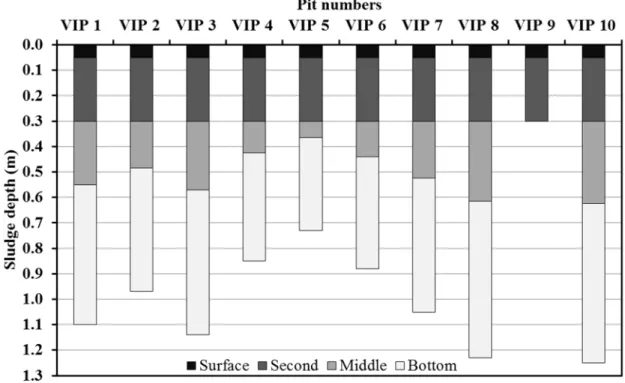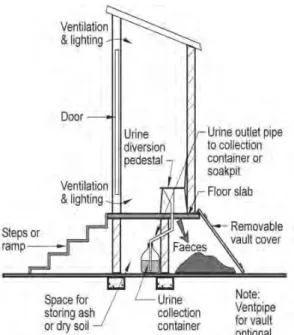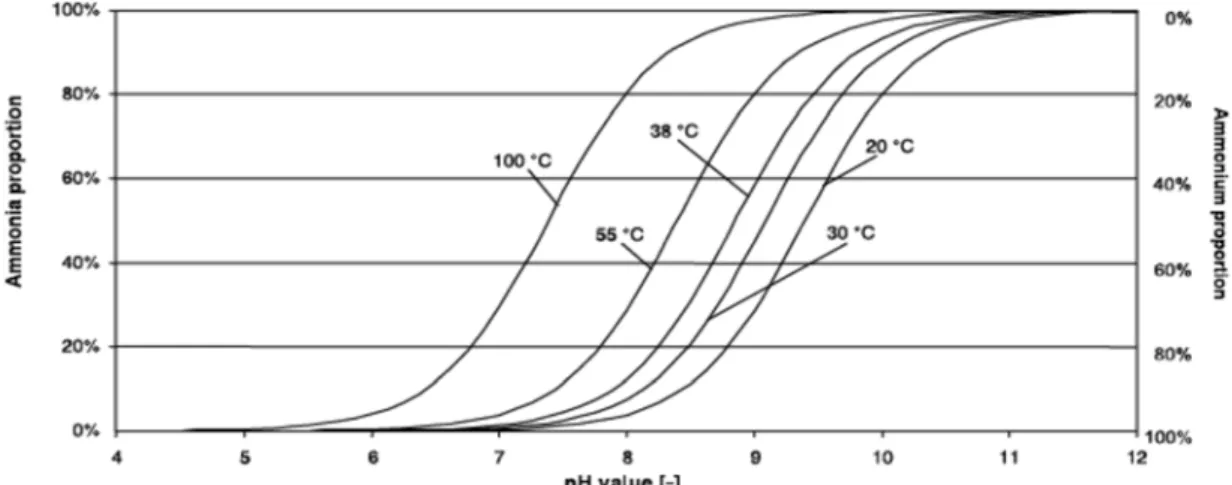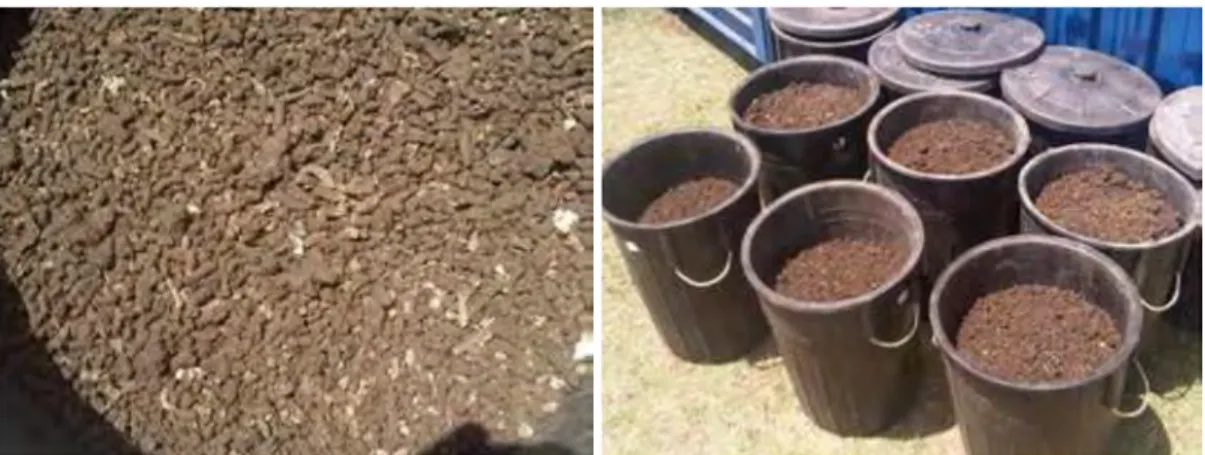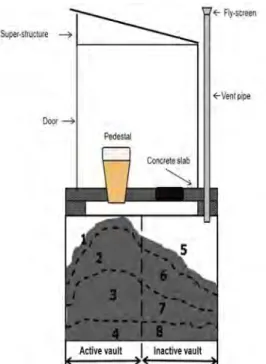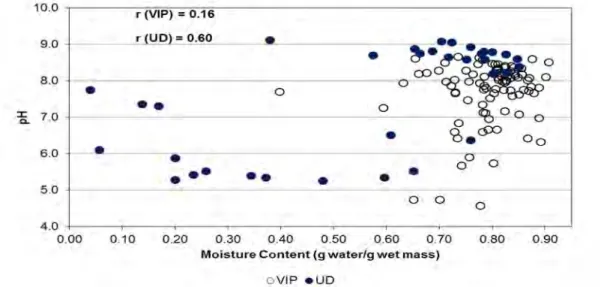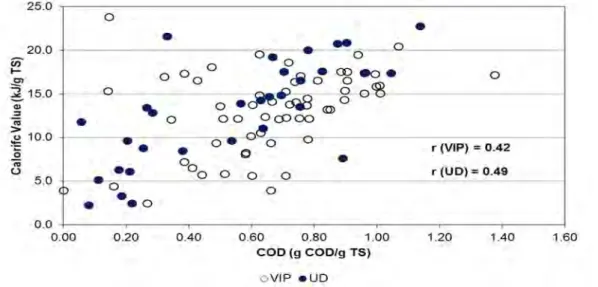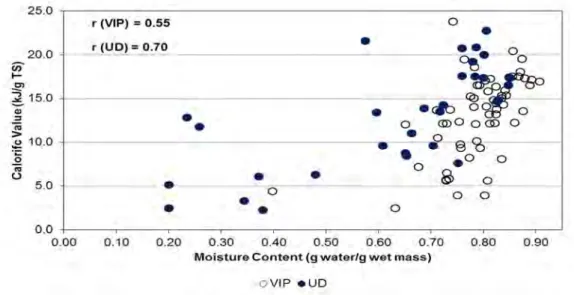However, no structured study has been conducted on the characteristics of the fecal sludge in UD vaults. The performance of UD toilets was determined based on the laboratory analysis results of the fecal sludge and visual observations in the field.
Objectives
Hypotheses
Outline of the thesis
This section discusses general on-site sanitation, and in particular the systems used in eThekwini Municipality, the inputs into these systems, the filling rates of these systems and the factors affecting sludge quality.
On-site sanitation
Components of VIP and UD toilets
Pits and vaults
Two major processes occur as a result of VIP use: the liquid excreta (mainly urine) infiltrate the surrounding soil, and the solid faeces are digested anaerobically or aerobically by bacterial activity (Mara, 1984). In UD toilets, the volume of material that requires handling is significantly less than in a VIP, so the vault should have less capacity than a VIP pit (Buckley et al., 2008b).
Superstructure
This continuous airflow removes odors from the well and allows the gases to escape into the atmosphere at the top of the vent pipe rather than through the superstructure (Franceys et al., 1992). The drop hole on which the pedestal is mounted is not in the center of the pit.
On-site sanitation in eThekwini Municipality (Durban)
The vaults are used alternately, on initial use the first vault is used and once it is full, the pedestal is switched to the second vault while the first vault is closed. When both vaults are full, the sludge in the first vault is considered safe enough (dry and pathogen-free) so that the householders can empty the vault themselves and bury the sludge in the open ground next to their residence.
Inputs into VIPs and UD toilets
Faeces
It was estimated during design that the vault will take 1 year to fill up (Buckley et al., 2008b).
Urine
Household waste
Filling rates of VIP latrines and UD toilet vaults
Sludge age and depth relationship
The rate of anaerobic digestion of organic content in VIP toilets depends on the age of the content. A study was conducted by Wood (2013) on the relation of sludge age in 2 VIP latrines, it was found that in both VIPs: Over time, a significant volume of faeces is no longer present in the pit through degradation biological, leaching of soluble components and dehydration.
Factors affecting faecal sludge characteristics
- Processes in pit and vaults
- Moisture
- Temperature
- pH
- Surrounding soil conditions
- Storage period
However, these studies only provide a one-dimensional (vertical) picture of the moisture movement in the well, which provides limitations. The presence and height of groundwater will affect the movement of moisture into and out of the well.
End use of faecal sludge
Nitrogen
Ammonia is the most widely used of all forms of inorganic nitrogen (Anderson et al., 2003). However, at pH values compatible with anaerobic digestion (pH 8), the equilibrium shifts to the more toxic free ammonia (Anderson et al., 2003).
Calorific value
Ammonia can be present in the form of ammonium ion (NH4+) or in the form of dissolved ammonia gas (NH3). A study conducted by Nakato et al. 2012) on faecal sludge from different types of on-site sanitation facilities (septic tanks, unlined, partially lined and fully lined pit latrines) in Kampala, Dakar and Kumasi concluded that calorific value did not vary significantly with source of sludge.
Thermal conductivity
Age and chemical oxygen demand (COD) content of faecal sludge was not a predictor for calorific value; however, sludge moisture affects its net calorific value. There has been no study on the calorific value of faecal sludge from VIPs and UD toilets in South Africa.
Faecal sludge management in eThekwini
- Emptying
- Transport
- Treatment
- Disposal and/or end use
- FSM Costs
The fecal sludge had to be buried in the household garden and a tree planted over it. The 250 liter bins in which the fecal sludge from VIP latrines is placed are transported to the processing site in trucks and vans.
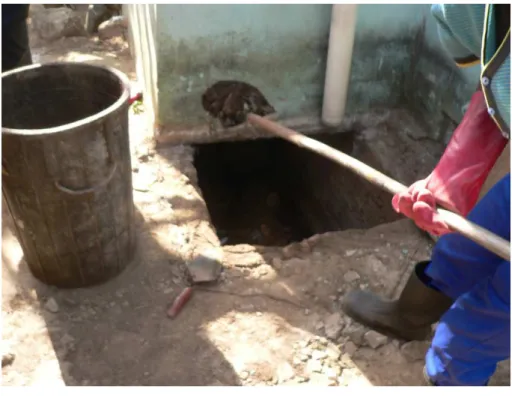
Faecal sludge characteristics in eThekwini
Fecal sludge samples (15) were selected from 11 standing UD vaults, which were analyzed for moisture content, volatile solids content, ash content and COD with the aim of characterizing the biodegradation process in pits using anaerobic test of serum bottles. These studies show that examining the contents of pit latrines can help to understand the processes occurring in the pits and the conditions of some of the pits in eThekwini.
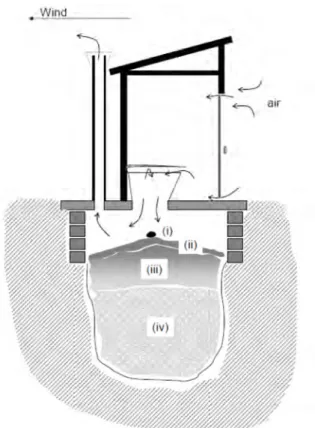
Innovations in sanitation – the need for data
Summary
Drainage and sampling of 30 on-site sanitation systems consisting of 20 VIP latrines and 10 UD toilets (active and standing vaults) was carried out as part of this project. The laboratory analysis of the faecal sludge samples was carried out at the PRG laboratory at UKZN.
Description of sampling site areas
Sludge emptying and sampling
VIPs
Samples of the thickened faecal sludge at the bottom of the pit were not taken. For each well, the middle layer came from the halfway mark of the mud depth.
UD toilets
Pit and vault content characterisation
Experimental methods
Method for laboratory analysis
Sample preparation
Thermal conductivity and calorific value analysis
Laboratory analysis
The VIP latrine results are presented through an analysis of the types of VIP latrines noted during pit emptying. The sampling locations of the VIP latrines are analyzed using statistics and the results of the characterization of the pit and vault contents are presented and discussed.
Data consistency check
- Volatile solids
- COD
- pH
- Ammonia
- TKN
- Thermal conductivity
- Calorific value
- Discussion
A positive correlation is expected between faecal moisture content and volatile solids in VIP toilets. An R-value of 0.45 indicates that there is little or no correlation between moisture content and COD in fecal sludge from VIP latrines (Figure 4-2).
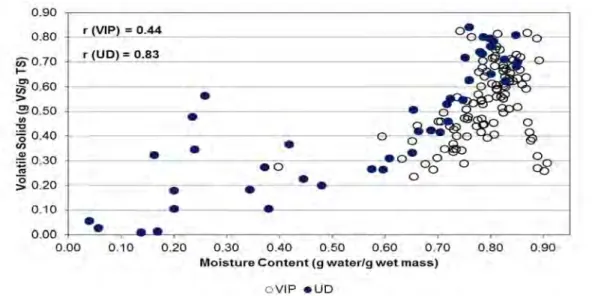
UD toilets
- Status of UD toilets
- Moisture content
- Volatile solids
- COD
- pH
- Ammonia
- TKN
- Thermal conductivity
- Calorific value
- Discussion
Faecal sludge from 3 UD toilet vaults which were found to be functioning properly by visual observation ie. there was no noticeable trend of fecal sludge COD from the surface to the bottom layers of the standing vaults. Faecal sludge from active UD toilet vaults that have been found not to separate urine mostly have a pH above 8 (Figure 4-13).
The thermal conductivity of the fecal sludge in the standing vaults is comparable to that of the active vaults. The calorific value of the fecal sludge in the active vault ranges from 21 to 83 kJ/g VS (Figure 4-17).
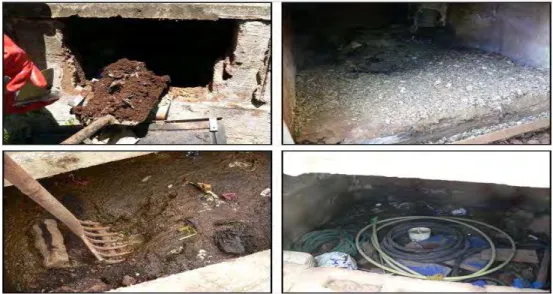
VIPs
Dry vs wet VIP analysis
All moisture content data for all wet and dry VIP latrines are plotted on one graph (Figure 4-20). Faecal sludge from dry VIP latrines and wet VIP latrines Type I are similar in moisture content, while faecal sludge from wet VIP latrines Type II has a lower moisture content. No significant difference (p>0.05) was found in the moisture content of faecal sludge from the categories of VIPs; dry VIP vs wet VIP Type I (p=0.42); dry VIP latrines vs wet VIP latrines Type II (p=0.28); wet VIP latrines Type I vs wet VIP latrines Type II (p=0.19).
The results from Figure 4-20 show that there was no clear distinction between the three types of VIP toilets in terms of moisture content. From these results, at the 95% level of significance, the characteristic properties of faecal sludge from different types of VIP toilets are not significantly different.
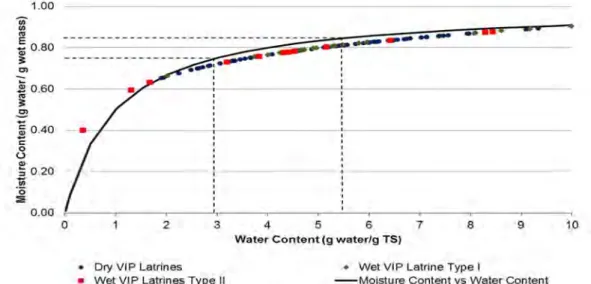
Dry VIP latrines
- Moisture content
- Volatile solids
- COD
- pH
- Ammonia
- TKN
- Thermal conductivity
- Calorific value
- Discussion
There is no significant difference in the pH of the pit sections (Figure 4-29). The front part of the pit has a greater variation in ammonia content than the back part. On average, the rear part of the pit has a higher thermal conductivity than the front part.
There is a greater variation in the calorific value in the front part of the pit than in the back part. The calorific value of the faecal sludge in the rear part of the well changes more steeply (the slope) than the front part of the well.
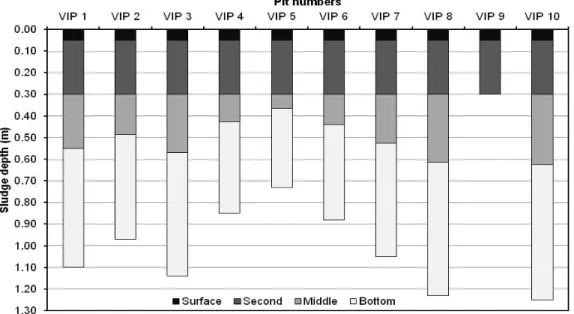
Sampling location for dry VIPs latrines
Faecal sludge property by front and back section
Faecal sludge characteristics by layers
Discussion
At the rear part of the pit, the depth should be divided into 4 sections, as done in the study, if the moisture content and characteristics that are indicators of organic content are required. The bottom layer for this study was too large (there was a significant difference between the middle and bottom layers in terms of moisture content, volatile solids content, COD) – it is recommended to place the bottom layer in the back part of the pit to be distributed even further. In all other cases, 1 sample can be selected representing the entire back part of the well.
The number of samples required from a VIP latrine to adequately describe each characteristic can be found in Table 4-7.
Wet VIP latrines
Differences in the 2 types of wet VIPs
The source of excessive water in wet wells is believed to come from the users adding water into the well or from a high water table in the area that causes water intrusion into the well. However, the mechanism causing these two different types of wet VIP latrines noted in this study is not known.
Sampling in wet VIPs
Analysis results for wet VIP latrines
Pit and vault content characterisation
The types of household waste found in dry VIP latrines varied depending on the habits of the users, the demographics of the household and the type of cleaning materials used. The differences in the paper content of the two wells may be due to the use of toilet paper versus the use of newspaper which takes longer to break down. Using the pits and vaults as garbage bins shortens the lifespan of the pits and vaults because the material is non-biodegradable and accumulates (Wood, 2013).
(Still et al., 2012) assume that in VIP latrines household waste makes up 5 – 10% of the pit contents and when the sludge has been in the pit for 10 years, rubbish will make up 25% of the volume. . The results of laboratory tests of these sanitary systems at the site were presented, explained and discussed in Chapter 4.
UD toilets
There were 10 dry VIP latrines, 10 wet VIP latrines, 9 active UD toilet vaults and 7 inactive UD toilet vaults that were emptied and sampled as detailed in Chapter 3.
VIPs
Surface layer samples (to a depth of 50 mm) were taken from the front and back of the well. The samples of the second layer were then taken from the front and back of the pit. Manual sorting of the contents of a VIP: (a) sludge removed from a container, (b) sorting through the sludge, (c) textiles separated from the sludge (Photo: Lungi Zuma, September 2012).
Throughout the well, there was a decrease in fecal sludge COD with increasing well depth. The ammonia content in the fecal sludge decreased as the sludge depth increased for both sections of the well. There was a decrease in TKN content in fecal sludge as the well depth increased in both sections of the well.
Volatile solids content and COD can both be used to determine the organic matter content of faecal sludge.
